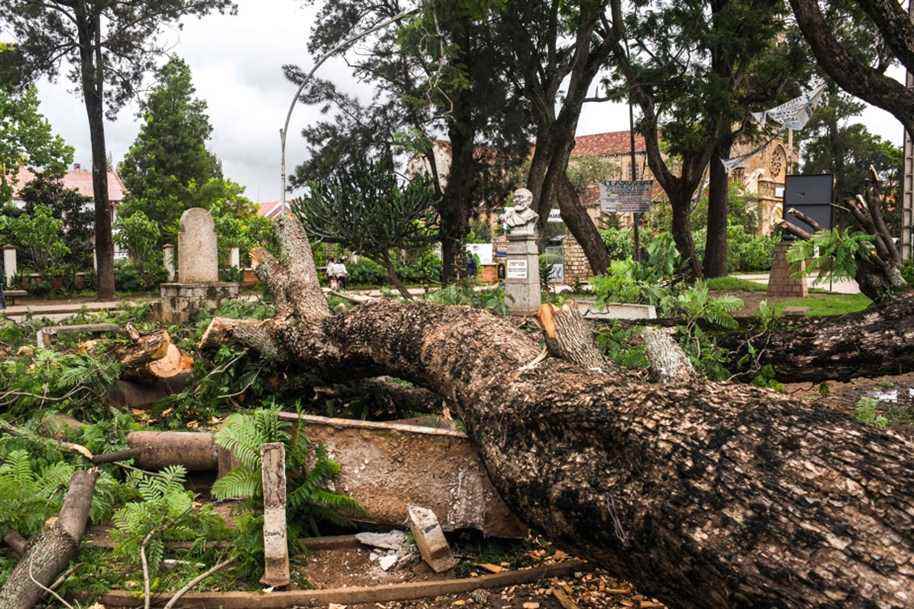(Mahanoro) At least 10 people died during the passage of the tropical cyclone Batsirai in Madagascar overnight from Saturday to Sunday, forcing nearly 50,000 people to leave their homes due to the risk of flooding, according to the authorities.
Updated yesterday at 12:38 p.m.
Batsirai weakened overnight, after partly ravaging the island, one of the world’s poorest countries, already hit by a deadly January tropical storm, Ana, and swept by wind and rain since Friday keep on going.
An official of the National Office for Risk and Disaster Management in Madagascar, Paolo Emilio Raholinarivo, told AFP that at least 10 people had died and nearly 48,000 were displaced by bad weather, according to a provisional report. The previous report had reported 6 dead.
According to Météo-Madagascar, Batsirai should “go out to sea in the Mozambique Channel at the level of the northern part of Atsimo Andrefana in the afternoon (Sunday) or next night”, after causing floods across the country, destroying buildings and uprooted from trees.
Batsirai had made landfall on Saturday evening in the form of an “intense tropical cyclone”, with winds of 165 km / h, according to Faly Aritiana Fabien, of the National Office of Risk Management.
On Sunday, the cyclone had weakened significantly, with winds averaging 80 km/h and gusts of 110 km/h – significantly less than the peaks of 235 km/h recorded on Saturday evening, according to Météo-Madagascar.
The inhabitants had prepared to cope with the means at their disposal, taking refuge in permanent buildings or ballasting their roofs with sandbags.
Waveswept graveyard

PHOTO LAURE VERNEAU, AGENCE FRANCE-PRESSE
Part of the Mahanoro cemetery was washed away by the waves.
In the city of Mahanoro (east), overlooking the sea, Marie Viviane Rasoanandrasana, sitting on the ground, lamented Sunday the damage caused by the cyclone in the municipal cemetery where her husband, her father-in-law and her daughter rest.
The waves swept away part of the cemetery, digging up several bodies, including those of his family.
” We are sad […] We have already had damage to the house because of the cyclone. Now this! “, lamented this 54-year-old widow. “A few days ago the sea was far away, but this morning I was told that it had washed away part of the cemetery.
“Daily life is already very hard,” she continued, before explaining that the remains would be placed in temporary graves until her family raised enough money for “proper burials”. In Mananjary, epicenter of the cyclone when it hit the island, the inhabitants contemplate their devastated city. “Mananjary is completely destroyed. Wherever you go, everything is destroyed,” said resident Faby.
Another man, Fana, estimates that “nearly 95% of the city has been destroyed. We beg the government to come and help us as soon as possible.”

PHOTO CYCLONEOI.COM, CYCLONEOI.COM VIA REUTERS
In Mananjary, epicenter of the cyclone when it hit the island, the inhabitants contemplate their devastated city. Mananjary is completely destroyed. Wherever you go, everything is destroyed,” said resident Faby.
Inland, in Antsirabe (365 km northwest of Mananjary), the wind brought down large trees in the city’s public park.
Global warming
When the storm Anna had hit Madagascar at the end of January, nearly sixty people had died, mainly in the capital Antananarivo. Dozens of other people had been killed in Malawi, Mozambique and Zimbabwe, also affected by Ana.
According to the World Food Program (WFP), Batsirai could cause “a major crisis” in the former French colony.
On the French island of Réunion, off which Batsirai passed three days ago, nearly 10,000 people remained without electricity on Sunday evening, according to the operator of the electricity network Enedis. The cyclone injured 12 people there, and up to 145,000 people in total were without power.
Each year during the hurricane season (from November to April), about ten storms or cyclones cross the south-west of the Indian Ocean, from east to west, often claiming victims and causing significant damage, in Madagascar and somewhere else.
In 2018, the country had already suffered two deadly storms in a row: the cyclone Ava had killed 51 people in January, and his accomplice Eliakim killed 20 two months later. And in 2017, the cyclone Enawo killed at least 78 people.
Global warming is already causing more intense tropical storms and flooding, with a wetter atmosphere and disrupted rainy season—southern Madagascar was so far experiencing the worst drought in decades.
South African President Cyril Ramaphosa told an African Union summit in Addis Ababa, Ethiopia on Sunday that the continent was experiencing “the worst consequences of phenomena associated with global warming, such as droughts, floods and cyclones. “.
“Although not responsible for climate change, it is Africans who are the first to be affected and are paying the price,” he added.
